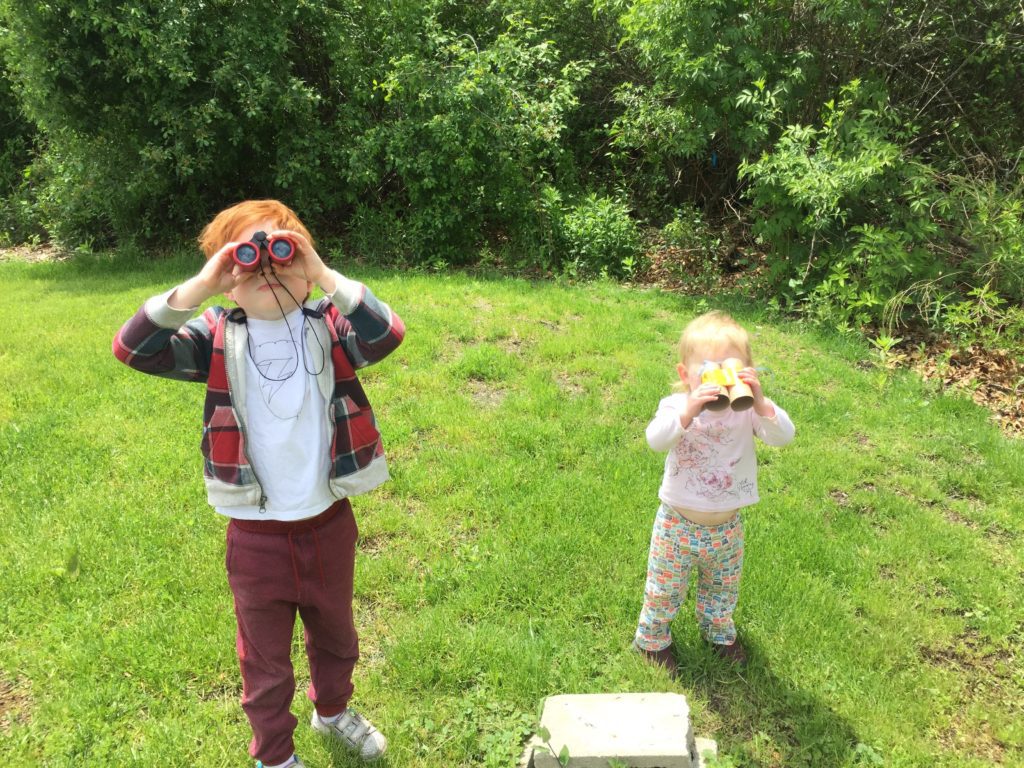By Phaea Crede
Patience. Stealth. Nuanced binocular adjustments. As far as hobbies go, birding isn’t what you’d exactly call “kid friendly.” But as a big bird nerd, I’ve been determined to get my little kids into bird watching one way or another. And I’ve learned two major things:
- Looking through binoculars while wearing a wiggly baby in an Ergo is difficult.
- With a few minor adjustments to my birding routine, taking the kids for a birding walk is totally possible.
So, if you want to get your fledgling brood out there trailing towhees and chatting with chickadees, here are a few simple ideas to get you started.
Gear up
Everyone knows the BEST part of a hobby is the gear, and birding is no exception. One simply must have a killer pair of binoculars to hit the trails. Harvey and Mabel both love to play with my Canon binocs, but are too young to actually use them. Happily, there are many toy binoculars available to buy, but you can go even more low tech and make your own out of two toilet paper rolls, tape, and a piece of yarn. Have your kids practice finding a stationary object through the “lenses,” like a street sign. Then have them:
– Look at the street sign just with their eyes.
– Without moving, raise the binoculars to eye level.
– Move binoculars as much as needed to center the street sign.
This is real-life binocular training!
Pick an easy species to look for
Recently, Harvey, Mabel and I went for a birding walk around Bellevue Pond with one goal and one goal only: spot american robins. We talked about what they looked like (grey with an orange chest) and what they’d be doing (singing in trees or foraging on the ground). Then we set out on our merry way.
And what do you know… we saw a bunch of them! Once Harvey (my older kid) saw one robin, it was easier and easier to see others digging through leaf piles. By the end of our 20-minute walk, he was a total expert on how to find and identify robins. Even my 20-month-old, Mabel, was getting into it, pointing and screaming in excitement. Which was cute – although it did scare the robin away…
Focus on ground birds
Robins, Grackles, Starlings, even the humble House Sparrow spend a lot of their time on the ground foraging for food. And that’s pretty convenient for kid-sized birders. Spotting a bird in a tree is much harder for my kids than noticing one hopping along a trail, so I always tell my kids to look down – not up.
Go birding listening, not bird watching
Instead of trying to see birds while walking, which can be tricky, tell your kids to listen for birds. Bird calls and songs, the rustling of leaves, the peeps of begging hatchlings, even the whistling sound of Mourning Dove wings are all signs of avian life. I bet they’ll be amazed at how many different bird-adjacent sounds they hear. And once they are in the habit of listening for the birds, finding and identifying the birds will be that much easier later on. And along those same lines:
Look for signs of life
Nests. Feathers. Poop piles. These signs all mean that a bird has been there recently, and have the added benefit of being stationary. And touching a feather or pulling apart an owl pellet gives birding a nice physical aspect that my kids love. I bet yours will, too.
Celebrate the common
The beauty of common birds like blue jays, mallard ducks and pigeons is that they are big and easy to identify. I never pass up a chance to point out one of these big birds to my kids, and make just as much of a fuss about seeing a canada goose as seeing a canada warbler. (The bird nerds out there totally got that joke.) Harvey still talks about the day we saw 100 pigeons take off together and Mabel’s first few baby signs included “bird” and “duck.” An interest in these big, common birds now will only help grow their interest as they get older.
—
Birding with your family is a wonderful way to experience nature and discover wildlife, especially in the beautiful Fells sanctuary. And it’s never been more important to educate our children about birds. A recent study reported that half of North American birds are facing extinction due to climate change. While we must work as hard as we can to combat this dire news through political action and more, the only way to guarantee our birds will survive is to get the next generation involved. What starts out as a hobby might just blossom into a lifetime of stewardship, making a real impact of the lives of birds.
My family will be hitting the trails again soon. Hope to see you out there!
